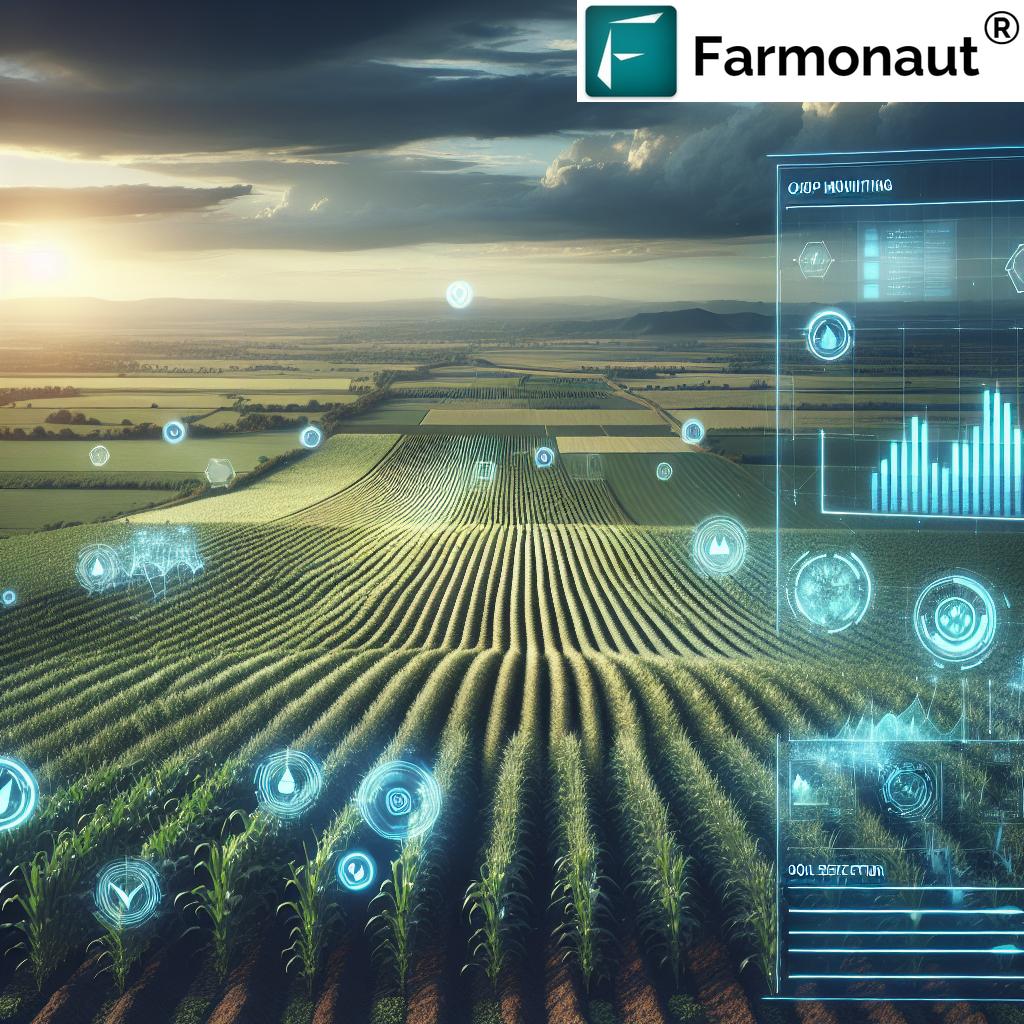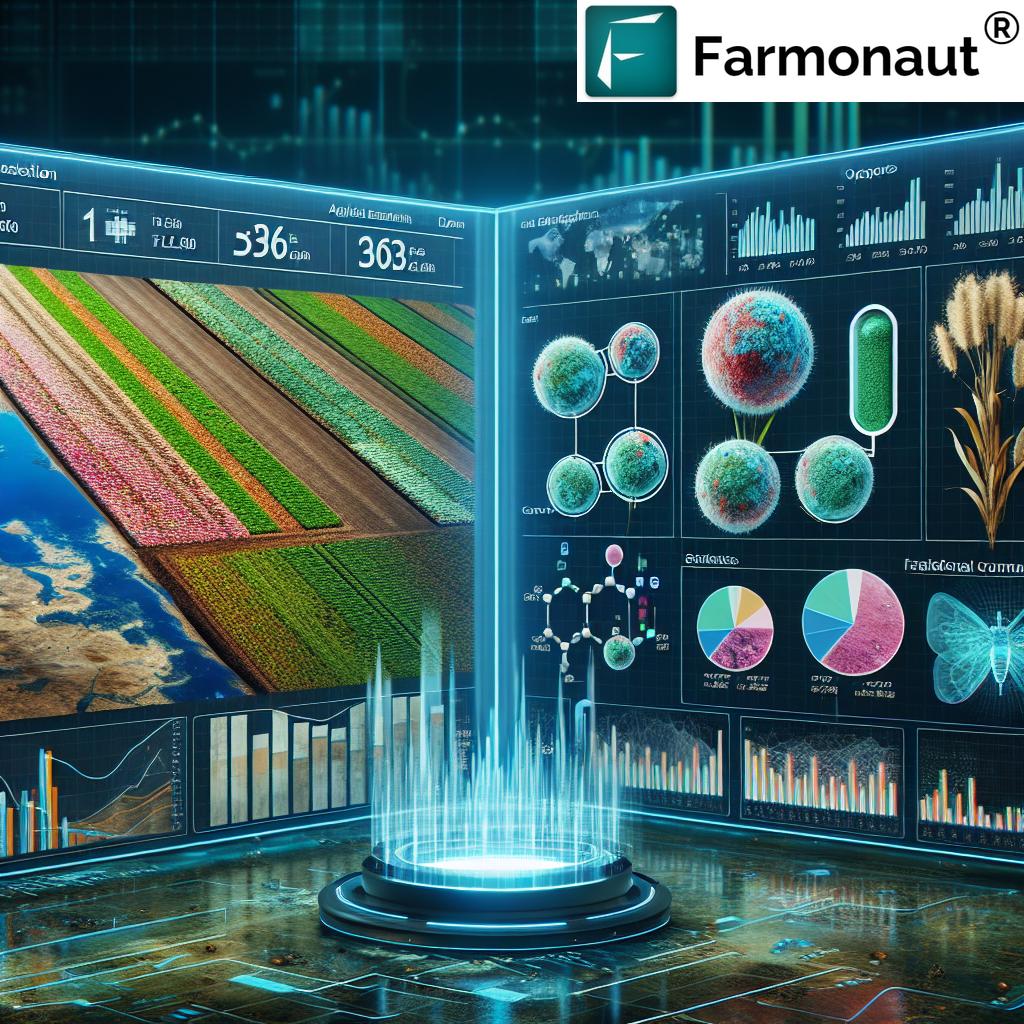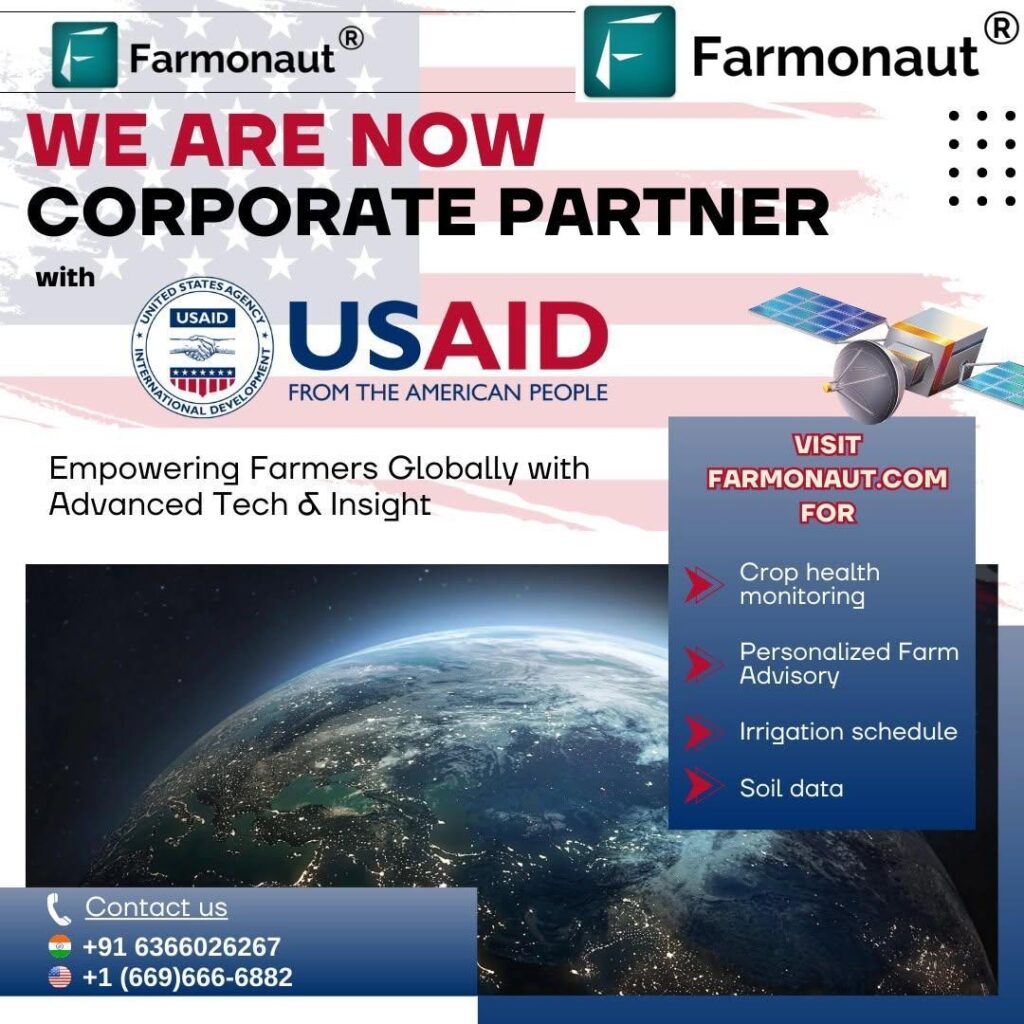Advantages and Disadvantages of Precision Agriculture 2025: Weighing the Future of Modern Farming
“By 2025, precision agriculture can reduce fertilizer use by up to 30%, but data management costs may rise 20%.”
- Introduction: Precision Agriculture in 2025
- What is Precision Agriculture?
- Key Technologies Shaping Precision Agriculture in 2025
- Comparative Pros and Cons Table: Key Technologies 2025
- Advantages of Precision Agriculture in 2025
- Disadvantages of Precision Agriculture in 2025
- Farmonaut’s Role in Precision Agriculture 2025
- FAQ: Precision Agriculture Advantages & Disadvantages
- Conclusion: Navigating Precision Agriculture in 2025 and Beyond
- Farmonaut Subscriptions and Resources
Introduction: Precision Agriculture in 2025
Precision agriculture in 2025 stands as a beacon of hope for sustainable, data-driven food production. It is known for revolutionizing the way modern farming operates, utilizing a fleet of advanced technologies like GPS, IoT sensors, drones, and satellite imaging—transforming how farmers manage crops at every stage. As stakeholders, we must carefully weigh the advantages and disadvantages of precision agriculture to navigate both its potential and its significant challenges, especially concerning costs, data management, and social impact.
This comprehensive guide uncovers the most compelling advantages and disadvantages of precision agriculture and precision farming in 2025. Within each section, practical insights and examples highlight the key factors that modern farmers and agricultural stakeholders should consider—including technology adoption barriers, cost concerns, and indispensable tools for a more sustainable, efficient farming future.
In this blog, the focus is on the disadvantages of precision agriculture and advantages and disadvantages of precision farming—from technical complexity to improved yields, and everything in between.
What is Precision Agriculture?
Precision agriculture, also referred to as precision farming, is an integrated crop management strategy that uses advanced technologies—such as remote sensing, satellite imaging, GPS-guided machines, drones, IoT sensors, data analytics, and automation—to monitor and optimize field-level variables in real-time. This site-specific and data-driven approach guides the amount and place of input applications, from fertilizers to pesticides and irrigation—delivering the right input at the right place and right time, for each unique zone of the farm.
By delivering targeted recommendations and automating processes, precision agriculture promises a host of benefits, but it also introduces new challenges—notably for smallholders, and those facing rural connectivity or knowledge barriers in 2025.
Key Technologies Shaping Precision Agriculture in 2025
The advantages and disadvantages of precision agriculture in 2025 are shaped by rapid advancements in several core technologies:
- Satellite Imaging & Remote Sensing: Real-time, multi-spectral observations for crop health, soil moisture, and resource management at scale.
- Drones & UAVs: Deployed for aerial surveys, targeted chemical application, crop scouting, and yield estimation.
- IoT Sensors: On-ground devices monitoring soil conditions, weather, irrigation needs, and pest levels.
- Automated Machinery: Tractors, harvesters, and planters equipped with GPS and AI for efficiency and reduced labor needs.
- Farm Management Platforms: Integrated platforms for data aggregation, analytics, and remote monitoring.
- Artificial Intelligence (AI) & Machine Learning: For predictive analytics, yield forecasting, and risk management.
- Blockchain: Secures data, ensures traceability, and enhances trust in supply chains.
The synergy between these technologies determines both the transformative potential and the barriers of precision agriculture in regions with varying infrastructure, costs, and educational landscapes.
Comparative Pros and Cons Table: Key Technologies 2025
Understanding the advantages and disadvantages of precision agriculture requires a side-by-side view of its most impactful technologies. The table below synthesizes key benefits and challenges, with estimated advantage and disadvantage values for each:
| Technology | Key Advantage | Estimated Advantage Value | Key Disadvantage | Estimated Disadvantage Value |
|---|---|---|---|---|
| Satellite Imaging | Large-scale crop health & soil monitoring | Yield increase: up to 15% | Subscription cost, skill/training required | ~$3–5/acre/year (platforms like Farmonaut) |
| Drones | Precise pest/disease detection and targeted input application | Fertilizer/pesticide reduction: up to 30% | High initial investment, maintenance | Implementation cost: ~$20,000/farm |
| IoT Sensors | Continuous data on soil, water, microclimate | Water usage reduction: up to 25% | Complex installation, data management challenges | Setup: ~$8,000/farm; data management costs up 20% |
| Automated Machinery | Reduced labor costs, consistent operations | Labor savings: up to 40% | Expensive hardware, technical complexity | Acquisition: $75,000–$200,000/machine |
| AI & Analytics Platforms | Data-driven decisions, predictive risk management | Prevention of yield loss: up to 18% | Expertise required, ongoing software fees | Platform/software: $2,000–$10,000/year |
| Blockchain Traceability | Supply chain transparency, reduced fraud | Food/fiber fraud loss reduction: up to 12% | Integration costs, learning curve | Implementation/maintenance: $5,000–$15,000/system |
Advantages of Precision Agriculture in 2025
The advantages of precision agriculture are rooted in increased productivity, sustainability, and the ability to optimize resource use. Let’s drill down into the top ways precision farming has transformed modern agriculture by 2025:
1. Enhanced Productivity and Yield
A primary advantage of precision agriculture lies in its ability to maximize crop yields. By integrating GPS-guided machinery, remote sensing, and drones, farmers can apply the correct amount of inputs—such as fertilizers, water, and pesticides—to the right segment of each field at the right time. This site-specific management ensures each plant receives what it needs, potentially boosting average yield by up to 15–20% in optimized operations.
- Reduces waste caused by over-application of chemicals or water
- Allows for variable rate applications, optimizing resources for each patch of soil
- Improves overall crop health and uniformity, making harvest and logistics more predictable
- Helps anticipate and address pest infestations or disease outbreaks early, with granular data from sensors and drone imagery
2. Resource Efficiency and Sustainability
Precision agriculture in 2025 is increasingly valued for promoting sustainable farming practices:
- Advanced soil monitoring and analysis via satellite images, IoT sensors, and remote sensing platforms enables farmers to maintain soil health and structure.
- Real-time data allows for better control over irrigation, reducing water consumption by up to 25% and combating climate change impacts.
- Targeted pest and disease management reduces excess chemical use, decreasing run-off and negative environmental impacts.
- Resource optimization aligns with regulatory and market pressures to ensure environmentally safe practices.
In line with these principles, platforms such as Farmonaut’s Carbon Footprinting solution provide environmental impact tracking, empowering farms to monitor, report, and minimize their carbon footprint across operations.
3. Cost Savings Over Time
While adoption requires substantial investments in technology and infrastructure, the cost savings of precision agriculture become evident in long-term operations. Here’s how:
- Automated machinery, such as GPS-enabled tractors and robotic planters, cut down manual labor requirements by up to 40%.
- Platforms offering satellite-based monitoring enable large-scale farm management without a physical presence on every field or remote farm, reducing operational costs.
- Efficient input use (fertilizers, chemicals, water) results in lower bills and lower storage costs.
- Data-driven crop planning can minimize risk, maximize returns, and help secure better insurance or loan conditions—services streamlining this process are available via Farmonaut’s Crop Loan and Insurance product for agricultural lenders.
“Over 60% of farmers cite high-tech equipment costs as a major barrier to adopting precision agriculture in 2025.”
4. Improved Decision-Making with Granular Data
With rich, continuous data streams from satellites, sensors, and field devices, farmers and stakeholders gain deep insight into every aspect of their operations. This granular data supports:
- Climate and weather pattern analysis for predicting irrigation needs and preparing for drought or storm events
- Diagnosing soil conditions and nutrient requirements zone-by-zone to optimize inputs
- Monitoring crop health and growth stages to fine-tune harvest timing
- Identifying pest infestations in real-time, enabling proactive intervention rather than reactive responses
Platforms like Farmonaut’s Large-scale Farm Management app are crucial for integrating these data sets and providing actionable, AI-powered insights for decision-makers.
5. Better Risk Management through Analytics
A transformative shift in 2025 is the predictive analytics capability delivered by AI-based tools. These technologies allow farmers to:
- Anticipate adverse events, such as droughts, floods, and pest outbreaks, using machine learning models trained on historical and real-time weather and crop data
- Implement mitigation strategies in advance to minimize losses and sustain operational continuity
- Reduce risk exposure and secure more reliable insurance and financing packages, supported by remote verification of crop conditions
These benefits are particularly relevant when paired with scalable farm monitoring via Farmonaut’s Fleet Management product, designed to optimize operational efficiency and resource management for agricultural machinery fleets.
6. Supply Chain Transparency & Financing
As agriculture globalizes and consumer expectations rise, blockchain-based traceability solutions shine. In 2025, these systems:
- Enable farmers and agri-businesses to track and verify the origin and journey of food products, ensuring authenticity and safety
- Decrease fraud risk and build consumer trust in both domestic and international markets
- Secure value in premium segments (organic, non-GMO, sustainable produce)
Comprehensive offerings are available—Farmonaut’s Product Traceability tool integrates blockchain for full lifecycle documentation and transparent supply chains in agriculture.
Disadvantages of Precision Agriculture in 2025
Despite their transformative potential, the disadvantages of precision agriculture are significant—especially when examined through the lens of cost, technical access, and socioeconomic impact. Let’s review the principal precision agriculture disadvantages that farmers, smallholders, and rural communities must navigate in 2025:
1. High Initial Costs & Infrastructure Needs
A top disadvantage of precision agriculture is the high upfront investment in hardware, software, sensors, drones, and network infrastructure:
- Typical automated machinery or drone fleets require initial outlays of $10,000–$200,000; IoT sensors and data management systems compound costs.
- Subscription fees for satellite data platforms, such as Farmonaut, are more scalable—but training and device access remain barriers for small and remote farms.
- This disparity may widen the gap between well-capitalized commercial farms and smallholders in both developed and emerging rural economies.
2. Technical Complexity and Education Gap
The need for advanced technical knowledge to use precision platforms is rising:
- Farmers must often understand data analytics, software platforms, sensor calibration, and troubleshooting equipment issues.
- Shortages of localized rural tech support and agricultural extension services slow adoption.
- Ongoing training and education are necessary to bridge the digital divide—and without these, the transformative benefits of precision may remain inaccessible for many.
In response, we at Farmonaut prioritize affordable access and simplicity in our platform design, aiming to democratize technology for users across expertise levels.
3. Data Privacy and Ownership Concerns
The massive volumes of farm data generated introduce vital questions:
- Who owns the data?—farmer, cooperative, or agri-tech vendor?
- How is sensitive data protected?—there is a risk of third-party exploitation by agrochemical firms, traders, insurers, or buyers.
- Privacy breaches may expose pricing strategies, operational secrets, or even compliance vulnerabilities, leading to distrust in technology adoption.
Blockchain-secured traceability tools—like Farmonaut Product Traceability—are steps in the right direction but legal and ethical frameworks continue to evolve.
4. Dependence on Connectivity & Infrastructure Gaps
Another major disadvantage of precision farming centers on poor digital infrastructure:
- Rural areas in many regions still lack stable, high-speed internet connectivity, impeding real-time data transmission from the field to the cloud.
- Technical failures—from server outages to hardware breakdowns or cyberattacks—can disrupt entire growing seasons, sometimes at critical moments like harvest or planting.
- This connectivity challenge is especially acute for smallholders and remote communities, underscoring the urgent need for both public and private investment in rural digital infrastructure.
5. Environmental, Social, and Labor Impacts
While aiming for sustainability, precision agriculture’s social and environmental ramifications must be considered:
- Over-reliance on technology sometimes marginalizes traditional ecological knowledge and native field practices, risking biodiversity and cultural loss.
- Accelerating automation shrinks manual workforce needs, affecting rural employment—especially in regions where farming is a major source of jobs.
- Questions remain over potential e-waste from frequent hardware upgrades and the manufacturing footprint of advanced machinery, drones, and sensors.
6. Uncertain Return On Investment
The “one-size-fits-all” benefits of precision ag do not always materialize:
- Yield improvements and cost efficiencies can be highly variable by farm size, climate zone, and crop type.
- In challenging soils, harsh weather, or with low-margin crops, ROI may fall short despite significant initial investments.
- Some AI-driven solutions remain in the early adoption phase, with unproven long-term reliability at scale, making them a gamble for cautious farm operators.
Farmonaut’s Role in Precision Agriculture 2025
We at Farmonaut are dedicated to making satellite-driven, AI-enabled insights more affordable and accessible for all stakeholders in agriculture. Our mission is to democratize advanced technology—helping smallholders, businesses, and governments alike to adopt cutting-edge solutions without prohibitive cost or complexity.
- Satellite-Based Monitoring: We enable multi-crop, multi-field oversight with NDVI, soil moisture, and crop health analytics, delivered via mobile and web apps.
- Jeevn AI Advisory: Our AI system generates weather forecasts, pest/disease alerts, and tailored strategies for improved decision-making.
- Blockchain Traceability: With traceability, we secure data integrity and foster transparency across the global value chain.
- Fleet and Resource Management: From vehicle usage tracking to carbon footprint analytics via environmental impact monitoring, our platform helps achieve operational and sustainability goals.
- API & Developer Tools: We offer scalable APIs at Farmonaut API and API Developer Docs to support seamless technology integration.
As the precision farming landscape evolves, our commitment is to address both the advantages and disadvantages with a transparent, science-first approach—empowering farmers, agronomists, agribusinesses, and policymakers to navigate complexity and build a sustainable, productive agricultural future.
FAQ: Precision Agriculture Advantages & Disadvantages
-
Q1. What is the main disadvantage of precision agriculture for smallholders in 2025?
A: The chief disadvantage is the high initial cost of acquiring and maintaining precision tech (drones, sensors, software), as well as the need for technical knowledge. This can impede adoption among smallholders or farms in regions with limited resources. -
Q2. How does precision agriculture improve yield and efficiency?
A: By enabling targeted, data-driven management—applying the optimal amount of inputs at the right place and time—yield is boosted, and waste is reduced. Real-time monitoring and analytics drive these efficiency gains. -
Q3. Are there privacy concerns in precision farming?
A: Yes. As vast amounts of detailed farm data are collected and managed by digital platforms, there are growing concerns about data privacy, ownership, and misuse. Secure blockchain-based solutions and robust data governance are essential as adoption grows. -
Q4. What role does connectivity play in the disadvantages of precision farming?
A: Dependence on stable internet connectivity, especially in rural areas, is a key limiting factor. Without robust infrastructure, the data flows and real-time response enabled by precision agriculture become unreliable, limiting effectiveness. -
Q5. Can automation in precision agriculture negatively impact rural jobs?
A: Potentially, yes. Increased use of robotic machinery and automation may reduce farm labor demands, with social and economic implications for regions where agriculture is a primary employer. -
Q6. Does Farmonaut offer solutions to both pros and cons of modern precision agriculture?
A: Yes. We strive to offer affordable, user-friendly satellite, AI, and blockchain solutions that help overcome cost and knowledge barriers, while also addressing key industry challenges with transparency and sustainability at the core.
Conclusion: Navigating Precision Agriculture in 2025 and Beyond
As we look ahead to 2025, precision agriculture stands at the crossroads of promise and complexity. Its advantages—ranging from yield improvement, resource efficiency, and cost savings, to advanced risk management and supply chain transparency—offer a pivotal path forward for sustainable food production worldwide.
However, the disadvantages of precision agriculture—notably high initial costs, infrastructure and connectivity barriers, technical complexity, social issues, and significant privacy concerns—must be carefully navigated by farmers, businesses, and policymakers in every region.
Smart integration of these solutions—with balanced attention to education, infrastructure, and affordability—is essential. It is imperative for stakeholders to promote broader adoption, invest in rural digital access, support smallholders, and develop clear data ethics. Only by bridging the gap between traditional knowledge and high-tech innovation can precision farming achieve its full potential.
If you’re seeking actionable, science-driven, and scalable precision agriculture solutions in 2025, get started with Farmonaut’s full suite of applications below or contact us for more information.
Farmonaut Subscriptions and Resources
Focus Keywords: precision agriculture disadvantages, disadvantages of precision agriculture, disadvantages of precision farming, advantages and disadvantages of precision agriculture, advantages and disadvantages of precision farming have been included through all sections to optimize for Yoast SEO and ensure comprehensive topic coverage for modern agricultural stakeholders.













